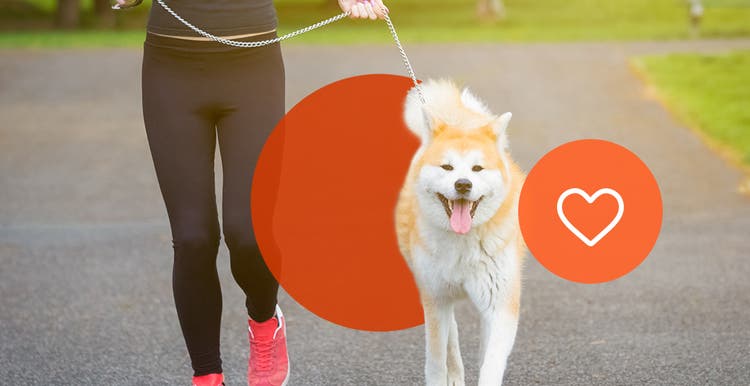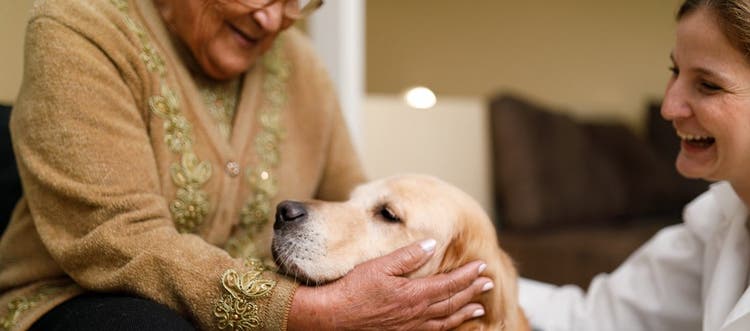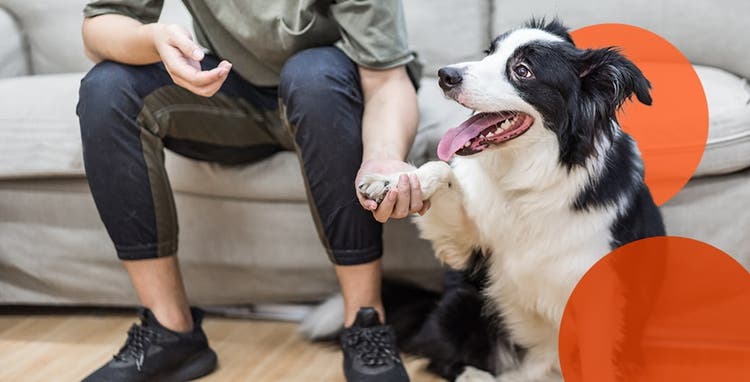These leash training tips can help make a daunting task easier.
Training a dog to walk on a leash is an invaluable life skill that offers important opportunities for enrichment, engagement, fitness and socialization. Leash training a puppy or dog may sound like a relatively simple task, but it can feel intimidating if you’ve never taken it on before.
Get started in the right direction by following these simple leash training tips.
How to Train a Dog to Walk on a Leash: Getting Started
Teaching your pup how to properly walk on a leash can prevent them from developing bad habits like tugging or lunging and can help make walks a more pleasant experience for both of you. But even before the lessons start, you’ll need to do a little prep.
Gather Your Supplies
Time to gather the right supplies! Your leash training starter kit should include:
- Flat-buckle collar
- Snug-fitting step-in harness that buckles at the back
- Nonretractable 6-foot leash
- Your puppy’s favorite treats in a portable treat pouch
While a collar is likely one of the first things you purchased for your dog, trainers recommend the use of a well-fitting harness for leash training. Harnesses are less likely to cause harm or discomfort for your dog during training and don’t restrict their natural gait. Look for one that buckles at the back and features a step-in style for easy use.
Retractable leashes appeal to dog owners for many reasons, but they’re not ideal for training. Retractable leashes can reinforce the idea of leash pulling and allow for too much distance between you and your trainee, limiting effective communication. Instead, choose a comfortable 6-foot leash for leash training and beyond.
Treats are vitally important to the leash training process as they promote positive reinforcement and association with leashed walks. Finding the tasty reward that your pup responds to can create a bond between you and encourage them to look to you for guidance through distractions.
Acclimate Your Pup
Properly introducing your dog to their new gear will help them get comfortable with the feeling of wearing a harness and leash prior to beginning the training process:
- Place the harness on the floor and allow your dog to investigate. Reward this effort to begin the positive association with their harness.
- Introduce a verbal cue that accompanies the treat reward. Pick a cue (it can be as simple as the word “yes” or a clicking sound) and reward your dog when they acknowledge the cue by shifting their attention to you. Your dog will start positively associating that cue, which will make it easier to transition away from treats later if you wish.
- Next, allow your dog to wear their harness around the house for a short time, increasing the duration as their comfort level grows. By first acclimating to the harness in a comfortable space, your dog will be less likely to develop an aversion to it. Reward calm behavior and small successes.
Leash Training a Dog Step-by-Step
Where and how to start your leash training journey is as simple as following the steps below. Start your puppy off in the comfort of your home, where they’re less likely to encounter distractions that can set them back. Once they’ve mastered some basics, graduate to walks in the yard and then within your neighborhood to test the skills they’ve learned and determine whether they are ready to be by your side in the big, wide world.
Step 1: Master Some Basics
Begin taking short “walks” around your house. At this point, your goal is to get your dog used to feeling restraint and following along with you. Here’s how to do it:
- Hold a treat in front of their nose and walk a few steps, encouraging them to follow.
- Reward them when they follow along as intended.
- Start with short 5- to 10-minute sessions several times a day, and gradually work up to 15-20 minutes as their comfort level grows.
During these short sessions, you can add some basic obedience commands such as “come,” “sit,” and “heel.” When your dog responds to these commands as desired, reward their efforts.
Step 2: Broaden Your Surroundings
When you feel your dog is ready, take the training outside to a familiar area, such as your backyard. By changing the training environment but keeping it familiar, you’re introducing some controlled distractions to your leash training lessons.
Take this opportunity to work on recall commands and continue to improve your dog’s comfort with walking next to you on a loose leash. They’re bound to get distracted; when they do, reward them when they return their attention to you.
The time and effort you spend on these lessons in a controlled and comfortable environment will set the stage for how your puppy will act when in unfamiliar environments later.
Step 3: Test Your Skills
When you notice your dog reliably looking to you for guidance and properly responding to cues on the leash, it’s time to put your skills to the test.
First choose a local park or place that you are familiar with. Pick a location likely to have an appropriate level of distraction to fully test the skills your dog has learned, but not so overwhelming that they have no hope for connection. Remember that new environments can be both exciting and overstimulating for any dog!
When you feel your dog is ready to graduate to additional locations (i.e., they’re consistently following the given commands despite external distractions, etc.), begin expanding your adventures to test their skills in new and challenging environments. If you have a puppy, they’ll be able to handle additional training and external stressors as they grow and mature, which you can use to drive your outings together.
Consistency in these steps and patience in the overall process are the keys to success!
Common Leash Training Problems
While you may do everything right in the step-by-step leash training process and your pup may be performing reliably at home and in familiar environments, it’s likely you’ll encounter some hiccups along the way. Here’s how to deal.
How to Address Reactivity
Walking your dog is not a time to check out mentally. As you walk together, look ahead to see potential distractions or reactive opportunities and adjust accordingly beforehand to help curtail reactive behavior.
Depending on the distraction, you may need to change course or pause completely to allow your dog to refocus their energy on you. This may involve giving treats to keep their attention on you versus the external stimuli. Essentially, you’re redirecting your dog in a positive way and teaching them to look to you for guidance.
How to Train Your Dog to Walk on a Leash Without Tugging
Many dogs are inherently curious, and it’s natural for them to want to explore their environment — especially if it’s new! If excited, they may pull you towards whatever it is they want to investigate. Do not reward this behavior; instead, continue your forward movement. If your dog begins to pull, stop walking. Take this opportunity to reward slack in the leash, and when they give it, continue walking.
It is important to note that continuing your walk after the pulling behavior has stopped is the reward for your dog. Trainers advise against giving treat rewards when teaching your dog not to pull, because treats can reinforce the pulling behavior (i.e., from the dog’s perspective, they pull, they stop, they get a treat). Instead, reward your pup when they choose to calmly walk next to you with slack in the leash.
How to Keep Your Dog from Lagging Behind
If your dog is walking too slowly or constantly stopping to sniff, it’s likely they’re a bit apprehensive in their new environment. While many dogs find excitement in new places and exhibit a desire to explore, some show self-preservation tendencies and shut down when overstimulated.
Take this opportunity to reassure them and reward forward movement. It may be that your pup simply needs a moment to assess their surroundings before continuing. Giving them some time (within reason) is perfectly OK. Speak to them in an upbeat and positive tone, encouraging their forward movement and rewarding them when they comply. Above all, be patient and positive. Remember that your goal is to teach your dog to walk with you on a leash, and you may need to adjust the method to meet the needs of your individual pup.
Much of modern dog ownership involves including them in our daily lives, and leash training is an essential skill to accomplish that. Taking the time to leash train your dog or puppy correctly at the start of your relationship creates an invaluable bond and teaches life skills your dog needs to be a true partner.






